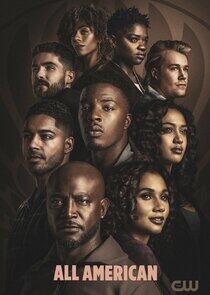A Century on Film - Season 2

Season 2

Episodes

The 20th Century Dawns
The 20th century was the first to be preserved in moving images. Drawing on new and rare footage from archives around the world, A Century on Film is a vivid portrait of humanity in the 20th century. In 1895, an audience of 30 watches Louis Lumiere's "Exiting the Factory" in a screening of short films at a Paris cafe. This short film was the first commercial film screening. A camera captures men dueling with sabers on the back streets of Paris. This episode traces the dawn of the film era from Queen Victoria's funeral and the end of China's Qing dynasty.

The Fall of Empires
Less than a generation after the invention of moving pictures, everyone is seeking ever-more exotic, exciting images. Cameras capture a man diving from the Eiffel Tower in a cape he invented as a parachute. The show ends in sudden death. In this episode, moving images record literary giant, Leo Tolstoy, The Russo-Japanese War, modern dance pioneer, Isadora Duncan, Russia's Bloody Sunday, the private life of the Romanovs, America's immigrant influx, the last czar of Russia, Nicholas II, and the event in Sarajevo that triggered World War I.

Perfecting Mechanized Killing
In 1914, Paris is only 50 kilometers from the fighting on the Marne River. The French army commandeers 600 Renault taxis to ferry reinforcements to the front. Moving images capture the birth of weapons of mass destruction such as poison gas, aerial bombing, and the first armored tanks inspired by tractors, as well as the carnage they caused. Winston Churchill and Charlie Chaplin also appear, as we trace the arc of war. After the armistice, we see an American Red Cross prosthesis workshop in Paris where the many disfigured by war come seeking masks to conceal their scars.

Manhattan: Crucible of an Era
By the 1920's, Manhattan is a warren of skyscrapers. It pumps out huge volumes of information, and feeds the burgeoning desires of the masses. Everyone is on the make for wealth and pleasure. Manhattan is forging a new mass society. In this episode, we turn our lens to American society in the 1920's, a world of light and shadow, of celebration and despair. We also see Duke Ellington, Babe Ruth, Charles Lindbergh and Japan's imperial succession.

Staring into the Abyss
In this episode, A Century on Film draws on rare archival footage to examine World War II. We see a nighttime bombing raid by the German Luftwaffe, and a plucky British eatery continuing to serve customers amid the rubble. On December 7, 1941, Japan attacks the US naval base at Pearl Harbor. Men of all ages, including Clark Gable and Joe DiMaggio, rush to volunteer for military service. In 1942, Germany's program to exterminate the Jews enters a new phase. Footage showing Jews being transported was taken covertly. The World War II was unprecedented in the scale of its attacks on unarmed civilians.

Under the Banner of Independence
This episode traces the difficult path traveled by Asian nations toward independence. In 1915, Mahatma Gandhi returns to his homeland from South Africa. India celebrates Gandhi's struggle for human rights and independence. Footage depicting Gandhi's philosophy in action shows unarmed men taking on a wall of British constables. In China in 1924, Sun Yat-sen seeks support from the Communist International, and starts a military academy to nurture a revolutionary army, with Chiang Kai-shek as commandant. Images convey 50 years of Western colonial imperialism, and the independence movements it inspired.

Travails of the Homeland
In this episode, A Century on Film continues its focus on the struggles for Asian independence and their remarkable leaders. In the late 1930's, Mao gains supreme power over party affairs. He is first captured on film in Yan'an. In 1941, after 30 years leading from behind the scenes abroad, Ho Chi Minh returns to his homeland. Footage of him from this period is mainly shot by Soviet cameramen. In 1946, Ho proclaims Vietnamese independence, and travels to Paris to negotiate terms. In January 1948, the world hears the news of Gandhi's assassination. Mao claims victory over the Nationalists in China in 1949.

The Victors Divide the World
This episode traces the transformation of Europe and Asia from the Yalta Conference to the dawn of the Cold War. Most of Eastern Europe is dominated by the Soviet Union, and Berlin is split into eastern and western zones. Movie theaters are built along both sides of the city and show propaganda films arguing the merits of communism and capitalism. In 1948, the Soviets mount a total blockade of West Berlin. Women perm their hair with heat from wood-fired stoves and printing presses run on muscle power. War in Korea breaks out in June 1950 and grim US soldiers leave home to join the fighting.

The Vietnam Shock
In this and the next episode, we explore a superpower shaken to its foundations as the war in Vietnam drags on. Through the 1960's, South Vietnam receives massive American support to prop it up against the communist north. In Saigon, a Buddhist monk immolates himself to protest the South's dictatorial regime. In 1963, African-Americans launch large-scale demonstrations against segregation under their leader, Reverend Martin Luther King, Jr. "We Shall Overcome" is their anthem. After the assassination of President Kennedy, Lyndon B. Johnson embarks on a major expansion of the war in Vietnam.

America: The Just Nation
This episode continues our look at the fissures opened in American society over US involvement in the Vietnam War and the treatment of African-Americans. On January 31, 1968, South Vietnamese commandos allied with the communist north enter the grounds of the US embassy in Saigon. Images of the fighting are relayed via satellite to American living rooms for the first time in history. On February 3, an insurgent commander is hauled before the national police chief. Footage of his roadside execution shocks the world. On April 3, Reverend Martin Luther King, Jr. gives his last speech.

Refugees: The Unending Tragedy Part 1
In this and the next episode of A Century on Film, we explore the dimensions of a global tragedy that reverberates today. Our first images of refugees date from late in World War I. Armenians flee the Ottoman Empire as it teeters on the brink of collapse. We look back at Russian refugees in 1921, displaced Poles in 1941, and the conflict between Croats and Serbs in World War II, including footage of Croats rounding up Serb civilians after their leader meets Hitler. We also trace the fate of Jews in Europe and Palestine from the 1920's to 1930's.

Refugees: The Unending Tragedy Part 2
We continue our exploration of how war and oppression made the 20th century a century of refugees. After World War II, 200,000 Jews attempt to reach Palestine. But Arab nations are opposed, and clashes break out across Palestine. In 1947, Britain abandons efforts to resolve the Palestinian question, and the United Nations passes a resolution to divide Palestine. At last the Jews have a homeland. Arab opposition is fierce, and sparks the first Arab-Israeli war. 700,000 Arabs are expelled from their homes. We also cover Hungary's uprising in 1956, the collapse of South Vietnam, and the genocide in Cambodia.

Japan through Foreign Eyes: Part 1
In this and the next episode, we explore Japan as seen from abroad, from the late Meiji era to postwar reconstruction. One of the oldest moving images shot in Tokyo shows a bustling road and the two-wheeled carriage called a rickshaw. It was shot in 1897, just 2 years after the Lumière's premiered their first movie. In the same year, cameras cover a lively area in Kyoto and star of the Kabuki theater, Sadanji Ichikawa. We also look at modern Japan's turning points; Japan's victory over Russia at Port Arthur, the assassination of Japanese statesman Hirobumi Ito, and the enthronement of Emperor Showa.

Japan through Foreign Eyes: Part 2
Friction between Japan and America over the fighting in China continues to grow. On December 7, 1941, Japan launches a surprise attack on Pearl Harbor. Japan occupies Indonesia and local sentiment begins to turn against the Japanese. During the war, Hollywood film director, Frank Capra is engaged to direct a movie to educate American servicemen about Japan. In August 1945, America drops nuclear bombs on Hiroshima and Nagasaki Prefecture, and Japan accepts the terms of the Potsdam Declaration. The war is over. Emperor Showa embarks on a tour of his war-ravaged nation, and is welcomed by 50,000 people in Hiroshima.
Recently Updated Shows

The Masked Singer
Based on an international hit, which already is a viral phenomenon with more than half a billion fans worldwide, and the No. 1 top-trending video of 2017 on YouTube, The Masked Singer features celebrities facing off against one another with one major twist: each singer is shrouded from head to toe in an elaborate costume, complete with full face mask to conceal his or her identity. Ken Jeong, Jenny McCarthy, Nicole Scherzinger and Robin Thicke serve on the panel and play detective, alongside host Nick Cannon.

Shark Tank
An exciting new reality show that, in these trying economic times, gives budding entrepreneurs a chance to make their dreams come true and become successful - and possibly wealthy - business people. But the entrepreneurs must first try to convince five tough, multi-millionaire tycoons to part with their own hard-earned cash and give them the funding they need to jumpstart their business ideas.
Enter the Sharks of Shark Tank, who lifted themselves up by their bootstraps to make their own entrepreneurial dreams come true and turned their ideas into empires. The five Sharks of this ruthless panel are real estate mogul Barbara Corcoran, "infomercial" industry pioneer Kevin Harrington, technology innovator Robert Herjavec, fashion icon Daymond John and financial expert Kevin O'Leary.

Elsbeth
Elsbeth follows Elsbeth Tascioni, an astute but unconventional attorney who utilizes her singular point of view to make unique observations and corner brilliant criminals alongside the NYPD. After leaving her successful legal career in Chicago to tackle a new investigative role in New York City, Elsbeth finds herself jockeying with the toast of the NYPD, Captain C.W. Wagner, a charismatic and revered leader. Working alongside Elsbeth is Officer Kaya Blanke, a stoic and ethical officer who quickly develops an appreciation for Elsbeth's insightful and offbeat ways.

All American
When a rising high school football player from South Central L.A. is recruited to play for Beverly Hills High, the wins, losses and struggles of two families from vastly different worlds — Compton and Beverly Hills — begin to collide. Inspired by the life of pro football player Spencer Paysinger.

Next Level Chef
Chef Gordon Ramsay scours the country for the very best line cooks, home chefs, social media stars, food truck owners and everything in between, all competing against one another with the goal of finding the food world's newest superstar. Joined by two elite names in the food world, chefs Nyesha Arrington and Richard Blais, Ramsay and his co-mentors leave no stone unturned, as they each recruit a group of talented chefs and take them under their wings. Ramsay and his friends attempt to bring out the very best in their cooks, as they all try to find "the one." Ramsay firmly believes that as long as a chef has the drive, talent and perseverance, he or she can make that climb to the top. Creativity, consistency and cunning are the recipe for success to make it to the next level, as the competitors adapt to the challenges waiting for them. Chefs compete for a life-changing $250,000 grand prize and the title of "Next Level Chef."